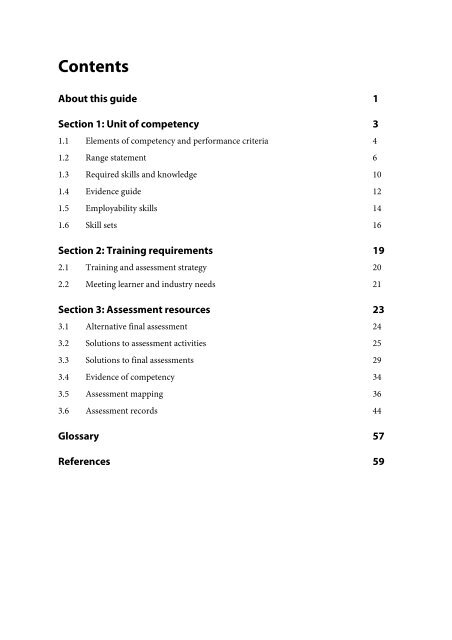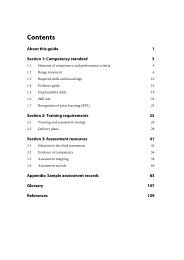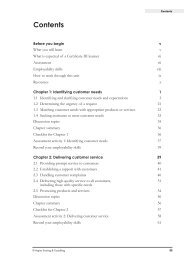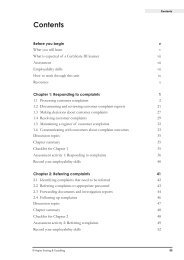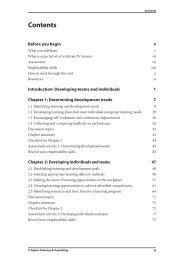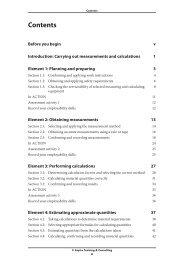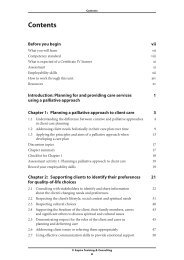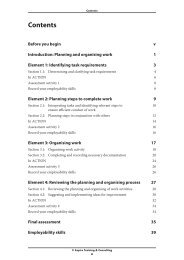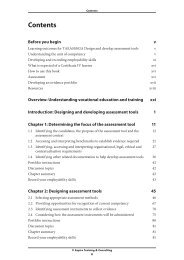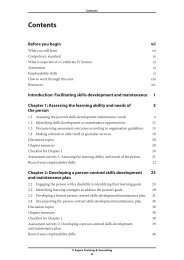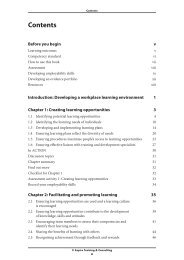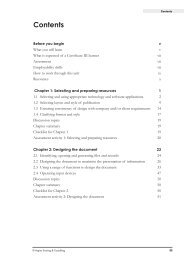view sample pages - Aspire Learning Resources
view sample pages - Aspire Learning Resources
view sample pages - Aspire Learning Resources
Create successful ePaper yourself
Turn your PDF publications into a flip-book with our unique Google optimized e-Paper software.
Contents<br />
About this guide 1<br />
Section 1: Unit of competency 3<br />
1.1 Elements of competency and performance criteria 4<br />
1.2 Range statement 6<br />
1.3 Required skills and knowledge 10<br />
1.4 Evidence guide 12<br />
1.5 Employability skills 14<br />
1.6 Skill sets 16<br />
Section 2: Training requirements 19<br />
2.1 Training and assessment strategy 20<br />
2.2 Meeting learner and industry needs 21<br />
Section 3: Assessment resources 23<br />
3.1 Alternative final assessment 24<br />
3.2 Solutions to assessment activities 25<br />
3.3 Solutions to final assessments 29<br />
3.4 Evidence of competency 34<br />
3.5 Assessment mapping 36<br />
3.6 Assessment records 44<br />
Glossary 57<br />
References 59
About this guide<br />
This guide is for trainers and assessors of unit TLIA3016A Use inventory systems to organise<br />
stock control. It complements the corresponding <strong>Aspire</strong> learner guide.<br />
As a trainer, you must develop and use training and assessment strategies that embrace the<br />
learner’s needs, educational background, preferred learning style and meet the<br />
requirements of the training package.<br />
This guide provides ideas on how you can encourage and support learners through the<br />
training and assessment process. It is designed to optimise the learner’s experience of<br />
TLIA3016A Use inventory systems to organise stock control and record details of their<br />
competency.<br />
The guide is divided into five sections:<br />
Section 1:<br />
Section 2:<br />
Section 3:<br />
Glossary<br />
References<br />
Unit of competency<br />
Training requirements<br />
Assessment resources<br />
How to use <strong>Aspire</strong>’s learner guides<br />
<strong>Aspire</strong>’s learner guides are structured to optimise learning experiences. The learner guide’s<br />
preliminary <strong>pages</strong> include:<br />
competency information<br />
employability skills information<br />
an introduction to the industry and the unit of competency.<br />
Each chapter matches an element in the unit of competency. Chapters are in plain English<br />
so they are easy for the learner to understand. The section headings within each chapter<br />
match the performance criteria.<br />
The learner guide content describes procedures and current industry practice and includes<br />
examples, checklists, documents, images and real-life case studies. There are also<br />
illustrations or diagrams to add interest and aid learning.<br />
The learner guide section tasks and assessment activities consolidate learning. It is up to<br />
you and the learner to decide which ones are necessary. Remember, these tasks and<br />
activities are not finite. You can add to them, change them or substitute your own tasks<br />
according to the interest level, the experience of the learners and the specific situation.<br />
© <strong>Aspire</strong> Training & Consulting<br />
1
Section 1:<br />
Unit of competency<br />
The TLI10 Transport and Logistics Training Package was developed by the Transport and<br />
Logistics Industry Skills Council in consultation with industry stakeholders including<br />
employers, unions, peak bodies, professional associations, regulatory bodies, registered<br />
training organisations (RTOs) and other relevant parties. The training package specifies the<br />
skills and knowledge required to perform effectively in the workplace.<br />
Individual units of competency are nationally agreed statements that describe work<br />
outcomes and can stand alone when applied in the workplace.<br />
This section outlines the requirements of the unit of competency for TLIA3016A Use<br />
inventory systems to organise stock control.<br />
Section one contains the following information:<br />
1.1 Elements of competency and performance criteria<br />
1.2 Range statement<br />
1.3 Required skills and knowledge<br />
1.4 Evidence guide<br />
1.5 Employability skills<br />
1.6 Skill sets<br />
1.7 Recognition assessment<br />
© <strong>Aspire</strong> Training & Consulting<br />
3
1.4 Evidence guide<br />
The evidence guide offers suggestions for assessment and must be read in conjunction with<br />
the performance criteria, required skills and knowledge, the range statement and the<br />
assessment guidelines for the training package.<br />
Critical aspects for assessment<br />
The evidence required to demonstrate competency in this unit must be relevant to and<br />
satisfy all of the requirements of the elements and performance criteria of this unit and<br />
include demonstration of applying:<br />
the underpinning skills and knowledge<br />
relevant legislation and workplace procedures<br />
other relevant aspects of the range statement.<br />
Context of and specific resources for assessment<br />
Performance is demonstrated consistently over a period of time and in a suitable range of<br />
contexts.<br />
<strong>Resources</strong> for assessment include:<br />
a range of relevant exercises, case studies and other simulated practical and/or<br />
knowledge assessment, and/or<br />
access to an appropriate range of relevant operational situations in the workplace.<br />
In both real and simulated environments, access is required to:<br />
relevant and appropriate materials and equipment, and<br />
applicable documentation including workplace procedures, regulations, codes of<br />
practice and operation manuals.<br />
Methods of assessment<br />
Assessment of this unit must be undertaken by a registered training organisation. As a<br />
minimum, assessment of knowledge must be conducted through appropriate written/oral<br />
tests. Practical assessment must occur:<br />
through activities in an appropriately simulated environment at the registered training<br />
organisation, and/or<br />
in an appropriate range of situations in the workplace.<br />
© <strong>Aspire</strong> Training & Consulting<br />
12
1.6 Skill sets<br />
Skill sets are single units of competency or combinations of units of competency that link to<br />
a licence, regulatory requirement or defined industry need.<br />
Skill sets do not replace qualifications as the foundation for undertaking work in the<br />
transport and logistics sector. Skill sets build on a relevant qualification and enable a<br />
qualified worker to move laterally into work areas addressed by the skill set or to broaden<br />
their skill base in relation to the services they provide.<br />
TLIA3016A Use inventory systems to organise stock control is not part of a Transport &<br />
Logistics Training Package skill set as identified by the National Industry Skills Council.<br />
© <strong>Aspire</strong> Training & Consulting<br />
16
Section 3:<br />
Assessment resources<br />
Assessment is all about collecting evidence and making decisions as to whether or not a<br />
learner has achieved competency. Assessment confirms the learner can perform to the<br />
expected workplace standard, as outlined in the units of competency.<br />
This section contains an alternative final assessment and model answers to the assessment<br />
activities in the corresponding <strong>Aspire</strong> learner guide. The <strong>Aspire</strong> assessment activities have<br />
also been mapped in section 3.5. Trainers and assessors can use this mapping information<br />
to complete the assessment records in section 3.6.<br />
It is an important responsibility of trainers and assessors to complete the assessment<br />
records themselves. This ensures all additional assessment activities deemed appropriate,<br />
outside those in the <strong>Aspire</strong> learner guide, are included in these records; for example,<br />
recording observation assessments.<br />
Section three contains the following information:<br />
3.1 Alternative final assessment<br />
3.2 Solutions to assessment activities<br />
3.3 Solutions to final assessments<br />
3.4 Evidence of competency<br />
3.5 Assessment mapping<br />
3.6 Assessment records<br />
© <strong>Aspire</strong> Training & Consulting<br />
23
3.2 Solutions to assessment activities<br />
The following solutions or model answers are to the assessment activities in the <strong>Aspire</strong><br />
TLIA3016A Use inventory systems to organise stock control learner guide. In many cases, the<br />
answers provided by learners will vary due to a number of factors, including the:<br />
learner’s own experiences<br />
learner’s workplace experiences<br />
training situations and strategies presented by the trainer<br />
interpretation of the assessment activity by the learner/assessor<br />
the type of organisation, work practices, processes and systems encountered by the<br />
learner.<br />
These solutions should serve as a reliable guide to the type of information that should be<br />
covered in the learner’s response. Assessors should have a copy of the activities to guide<br />
their assessment.<br />
Assessment activity 1<br />
1. Some inventory and stock control equipment used in warehouses include:<br />
barcode printer, barcode labels and accessories<br />
barcode scanners<br />
portable data collectors<br />
RFID (radio-frequency identification) scanners.<br />
2. Ensure the learner identified a piece of inventory/stock control equipment used in the<br />
workplace and prepared a training session on its use.<br />
3. Learners are asked to list at least five examples of inventory records used in their<br />
workplace for stock control. Check that they have gathered completed examples and<br />
provided an explanation of how the documentation is used.<br />
4. There are different ways in which all warehouse records can be consolidated within a<br />
common database system. A simple flow diagram might show the links between:<br />
equipment specifications<br />
work procedures<br />
warehouse forms and documents<br />
stock item records<br />
links to financial records.<br />
© <strong>Aspire</strong> Training & Consulting<br />
25
Gathering evidence<br />
Evidence can be gathered through:<br />
real work/real-time activities through observation and third-party reports<br />
structured activities.<br />
Evidence can also be gathered through:<br />
■ formative assessments: where assessment is progressive throughout the learning<br />
process and validated along the way by the trainer – also known as assessment for<br />
learning<br />
■ summative assessment: where assessment is an exercise or simulation at the end of the<br />
learning process – also known as assessment of learning.<br />
Evaluating evidence<br />
The following steps may help you evaluate evidence.<br />
Step 1: Evidence is gathered.<br />
Step 2: Rules of evidence are applied –<br />
evidence is valid, sufficient, current and authentic.<br />
Step 3: Evidence meets the full requirements of the<br />
unit/s of competency.<br />
Step 4: The assessment process is valid, reliable, fair and<br />
flexible.<br />
Step 5: The trainer or assessor makes a straightforward and<br />
informed judgment about the candidate and completes<br />
assessment records.<br />
© <strong>Aspire</strong> Training & Consulting<br />
35
3.6 Assessment records<br />
To comply with the critical aspects of assessment and evidence outlined in the unit of<br />
competency, learners must provide evidence of the specified required skills and knowledge.<br />
These should be assessed in the workplace or in a simulated workplace.<br />
Trainers can use the following assessment forms to record the learner’s evidence of<br />
competency.<br />
The pre-assessment checklist helps the trainer determine if the learner is ready for<br />
assessment.<br />
The self-assessment record allows the learner to assess their own abilities against the<br />
requirements of the unit of competency.<br />
The required skills checklist facilitates the observation process; allows trainers to<br />
identify skill gaps and provide useful feedback to learners.<br />
The required knowledge checklist can be used to record the learner’s understanding of<br />
the required knowledge; to identify knowledge gaps and to provide useful feedback to<br />
learners.<br />
The portfolio of evidence checklist helps the trainer annotate or detail aspects of the<br />
learner’s portfolio of evidence.<br />
The workplace assessment checklist can be used by the learner’s supervisor to show<br />
workplace-based evidence of competence.<br />
© <strong>Aspire</strong> Training & Consulting<br />
44


